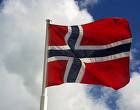...curious about the color of our house...it really stands out, being yellow and not white...

So why is there a yellow house in Old Stavanger?...

Most who wonder are surprised when I tell them that our yellow house is one of the few remaining that still have their original color.
The houses in old Old Stavanger simply weren't white!
Back in the 18th and 19th centuries paint was made from natural ingredients -
mainly boiled linseed oil - and colored by natural pigments.
Price for these pigments varied widely, with red being the cheapest and white the most expensive. Farmers thus tended to use red paint for their utility buildings - barns, sheds and so on - and reserve the expensive white paint for their own house...
The inhabitants of Old Stavanger, on the other hand, were only rarely sailors.
Mostly they worked in the canning industry that was the major source of income in Stavanger. For instance, the original owner of the house I live in was a cooper.
These weren't rich people, and they had no source of cheap white paint.
So they painted their properties in whatever color was available and that they could afford... They were green, ocher, blue, red and surely, in some cases, white...
Through elderly relatives we've been told that it was the same color back in 1907 when my wife's great grandfather bought the house.
So what happened?
When the city voted to preserve Old Stavanger back in the '60ies,
the old quarter was a bit of a slum... At the same time,
most of Old Stavanger was privately owned by people without much money.
To help these, the city voted to give out free paint to all owners.
And for some reason somebody...decided that the paint should be white, and that Old Stavanger would be more picturesque with all the houses the same color.
A very few of the property owners protested.
My father in law, who owned our house at that time, met with the city architect...and obtained his permission to exchange the free white paint for ocher. So a few houses in Old Stavanger remain in their original colors, ours even "by permission".
Every couple of years I can be found in a ladder repainting our house...
Almost every time I get to explain the mystery of the yellow house in Old Stavanger to passersby...over the past few years I've started to hear the same story told by the tour guides...
If you ever happen to pass a yellow house in Old Stavanger and notice a guy on top of a ladder, feel free to say "hi!"...
(Orig) Posted...Monday, April 02, 2007
Note: Excerpts above borrowed from The Old Stavanger Blog, you can read more there...
(few posts in English & a link to more in Norwegian & other links of interest about
Old Stavanger there too...)
Old Stavanger is also called "Gamle" Stavanger if you go off Googling on your own...

























